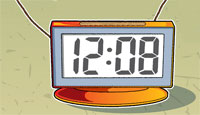How to Build a Lemon-Powered Clock
Power a digital clock by making a battery out of lemons.

WHAT YOU’LL NEED
- 2 ripe lemons
- Low-voltage digital clock (Use a clock that takes one AA battery or a 1.5-volt button cell battery. One AA battery has about 1.5 volts of energy. Two lemons should produce about 1.5 volts.)
- 2 copper pennies (If your penny has a date before 1982, it is made of 95 percent copper. If the date is 1982 or later, it is made of 97.5 percent zinc with a thin copper coating. The old pennies work better.)
- 3 8″ lengths of copper wire
- 2 galvanized nails (Galvanized nails are coated with zinc.)
- Knife
- Scissors
- Clip leads (alligator clips), optional
WHAT YOU’LL DO
 1. Roll the lemons on a hard surface, being careful not to break the skin. (This will loosen the pulp, make the lemons juicy and help the electrons move through the lemons.)
1. Roll the lemons on a hard surface, being careful not to break the skin. (This will loosen the pulp, make the lemons juicy and help the electrons move through the lemons.)
 2. Wrap one end of a wire around a penny and the other around the end of a nail. (These will be used to connect the lemons together. Connecting lemons with metal wires adds voltage from each lemon. The more lemons you connect together, the higher the voltage.)
2. Wrap one end of a wire around a penny and the other around the end of a nail. (These will be used to connect the lemons together. Connecting lemons with metal wires adds voltage from each lemon. The more lemons you connect together, the higher the voltage.)
 3. Connect a second wire to a penny and leave the other end bare.
3. Connect a second wire to a penny and leave the other end bare.
 4. Wrap the third wire around a nail and leave the other end bare.
4. Wrap the third wire around a nail and leave the other end bare.
 5. Cut a slit in each lemon just large enough to insert the pennies. Insert the pennies and nails as shown in the image at the top of this page. (Make sure the copper wire has good contact with both the pennies and nails, and make sure the pennies and the nails make good contact with the lemon pulp and juice.)
5. Cut a slit in each lemon just large enough to insert the pennies. Insert the pennies and nails as shown in the image at the top of this page. (Make sure the copper wire has good contact with both the pennies and nails, and make sure the pennies and the nails make good contact with the lemon pulp and juice.)
 6. Remove the battery from the clock and touch the wires to the positive and negative terminals in the clock. If your clock doesn’t work, try switching the wires.
6. Remove the battery from the clock and touch the wires to the positive and negative terminals in the clock. If your clock doesn’t work, try switching the wires.
7. You can also use clip leads (alligator clips) to connect your wires to the pennies, nails and clock, as shown below.

PHOTOS OF COMPLETED PROJECT
Check out these photos of completed lemon-powered clocks sent to us by Boys’ Life readers. If you have a photos of a BL Workshop project, please use the form below to send them to us.

It good
I love iiiiiittt
This is a bust i tried And tried And nothing
Test each lemon with a volt meter, I Had to use 3 lemons to get 1.5 volts but it worked. I ended up with 1.47 volts but the lemons were small. Experiment with zinc strip at different spacing, mine were 3/4″ apart. Fun experiment.
It made beaping noise but that means it worked
i will do that
thank you i have been so frusterated because mine werent working
it worked 🙂
Lol
Thanks helped alot with GCSE homework
That looks awesome but I can’t do it😥
Why!? It totes works, and got me a b+ in sci fair!
Haven’t tried but it sounds legible
That’s cool! I’m making one
It worked perfectly!